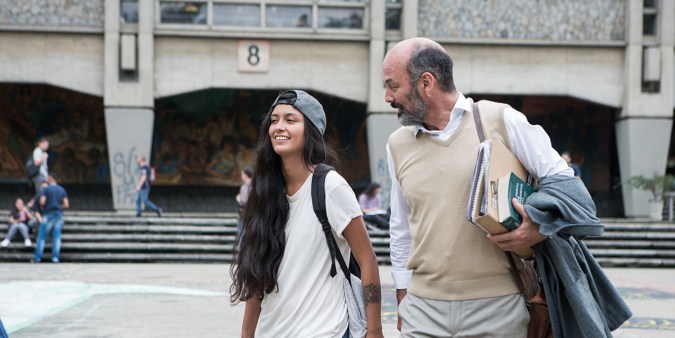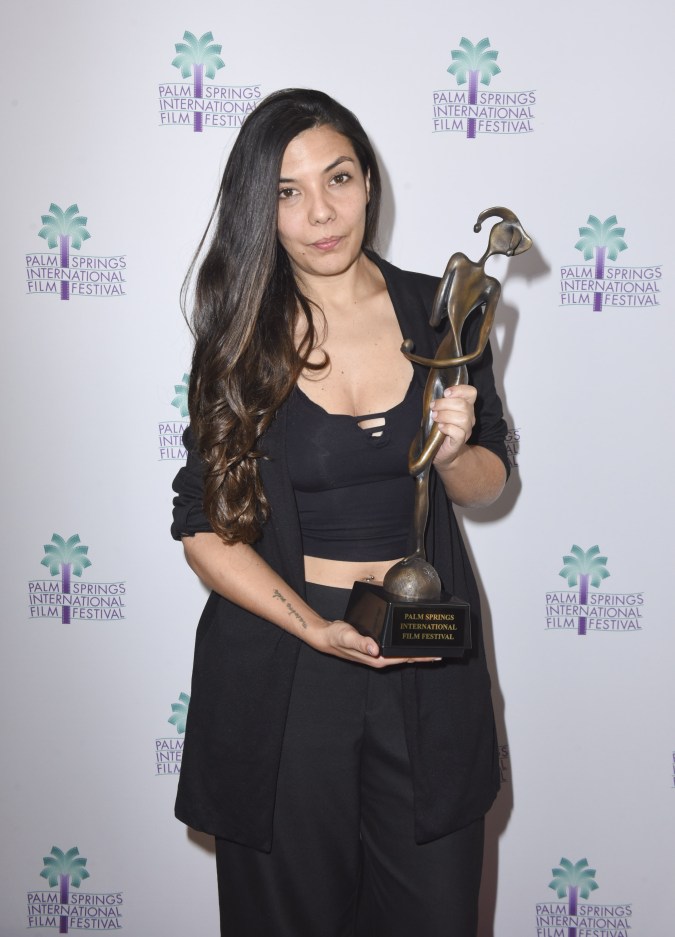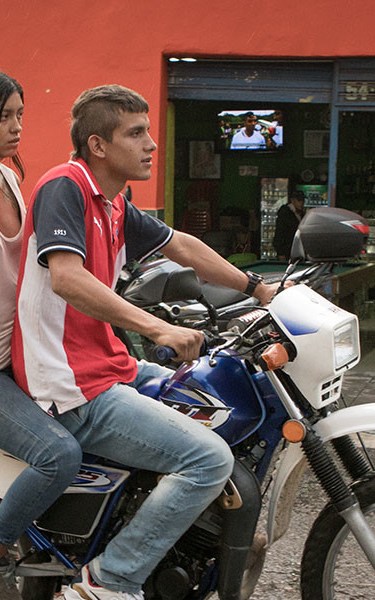Following the most gut-wrenching tragedy of her life, her father’s murder, director Laura Mora found herself unable to express the monstrous frustration and anger she felt. As she notes, a part of her also died that day. It wasn’t until years later when she had left her native Colombia that she was able to begin putting her feelings into writing and begin the strenuous process of developing her first feature-length film project, Matar a Jesús (Killing Jesus.) Since she was a director for hire, Mora doesn’t consider the TV movie, Antes del fuego, as her debut, but she is thankful for the enriching lessons learned during that production.
Serving as a kaleidoscopic portrayal of Medellín, with both sumptuous vistas and gritty urban landscapes, Killing Jesus is formally a realist work crafted using non-actors, real locations, handheld camera, and social justice themes. Like Mora, the protagonist of her film, Lita or Paula (Natasha Jaramillo), also loses her father to a violent crime and is unable to find resolution though institutional channels. However, young Lita, once a buoyant student and aspiring photographer, is afforded the opportunity to take revenge when she casually bumps into Jesús (Giovanny Rodríguez), her father’s killer. Weaving a thrilling and unpredictable plot, Lita infiltrates Jesús’ underworld by pretending to be romantically interested in him. In doing so, she forsakes her studies, her family, and her future. Her only motivation now is avenge her father’s death. To kill the killer, she has to become one.
A self-proclaimed fan of Remezcla, Mora, who recently won the Cine Latino Award at the Palms Springs International Film Festival, told us about exorcising such a painful chapter of her life on screen, Colombians’ unwillingness to confront the perpetual violence that has ravaged the country, and whether or not she could ever believe in forgiveness.
On the Story’s Profoundly Personal Origin
Killing Jesus is the most important project of my life to date. It’s a project that took me 10 years to write, the last four years I co-wrote with Alonso Torres, who is the screenwriter of films such as Perro come perro and Todos tus muertos. He is a great Caleño friend. I think working with him was the most intelligent decisions I made because it is a very personal story. It’s inspired in my father’s murder. My father was killed in 2002 when I was 22 years old. I didn’t know the sicario that killed my father and I wasn’t with him when it happened, that’s the fictional part. The film is a reflection on all the pain, and the lack of a functional justice system. I thought about what would have happened if I had run into person that did it, and it ended up being a love letter to my father.
On How a Dream Became the Catalyst for Her to Write the Screenplay
Writing the screenplay was very difficult. When my father was murdered a lot of professors and friends of his wrote me to tell me, “Why don’t you write something about your father?” I was always a good writer, but at that moment I wasn’t unable to do it. That was very frustrating for me and I think that translated into the character of Paula. Her silence reflects the fact that after it happened I couldn’t write. Two years after I went to live in Australia I had a dream in which I was at a lookout contemplating the city and smoking a joint. Suddenly a guy appears. He sits next to me and we start talking, then he tells me, “My name is Jesus and I killed your father.” I woke up in that moment, it was around 4:00 AM, and I started writing a text that was basically a description of this character. After that I would go to sleep thinking, “Hopefully I dream the same thing so that I can keep writing.” I titled those texts “Conversations with Jesus.” Later on, I knew this had to become a movie.
On How Both of Her Protagonists Are Victims of an Unjust System
Both of these kids are victims of system that has excluded them in different ways. Paula is excluded from getting justice and Jesus is excluded from birth by the context where he exists and the lack of love and education. It’s an excluding system. For me exclusion is the most brutal form of violence. These two kids share that exclusion from an ineffective and unjust system, but also from a powerful criminal apparatus that uses young kids, like Jesus, and transforms them into young victimizers at the service of this criminal system. These systems however, also have the potential of transforming a girl like Paula, who is young, educated, and raised with lots of love, into a potential killer. That criminal system of revenge is perpetuated. It was important for me to bring attention to the society we have constructed in Colombia that feeds on violence and revenge.

On How Violence Has Changed in Colombia Since Her Father’s Death
It was very important for me that the movie was current, precisely because violence has changed in Colombia. If we revise the history of Medellín from the 80s with the Medellín Cartel and Pablo Escobar, which was all over the media, violence has definitely changed and the violence indexes have dropped. 2002, the year my father was killed, was a very controversial year because paramilitary forces took over Antioquia, the region for which Medellín is the capital. Indexes have changed, but it’s very important for Colombians not to be afraid to recognize that we are still very violent, so that we can finally examine and reflect on this. I lived outside of Medellín for many years, I lived in Bogota and Australia following my father’s murder, and when I came back to make the movie I thought that maybe the city had changed and that the story I was trying to tell was not real anymore. What I found was a city that has changed positively, but we are still very violent.
On the Complexity of Shooting in 32 Locations Across Medellín
Medellín will always be my biggest source of inspiration. I’ve had a love-hate relationship with that city -more of love. It’s a very complex city. It’s a city where you can find endless love and at the same time endless hate. It’s a city that I know very well, despite the fact that I’ve lived abroad for a long time. One of the biggest lessons of the education that I received was that despite it being a very elitist city, my parents always wanted for me to inhabit the city in its entirety. They didn’t want me to be conscious of the class system. Even though I come from a middle class family, I’ve been able to travel across Medellín my whole life. I know how to navigate it, but it is complicated. There are very complex neighborhoods. We shot in 32 different locations. There are many neighborhoods in which the ruling authority is not the institutional authority, but instead the ones in control are kids from what are called “combos” or gangs. We had to go talk to them and tell them, “We have this project, we don’t have money, but we want to shoot here.” We tried not to be invasive and to incorporate people from those places into the movie. Many of the extras, some cast members, and even people from the production design department were from these neighborhoods, which meant they all really loved the project.
On Why She Enjoys Working with Non-Professional Actors
I really enjoy working with non-professional actors. There is a great tradition of working with non-actors in Colombia, such as in Victor Gaviria’s films Rodrigo D and La vendedora de rosas, which are also from Medellín. Victor is a great friend of mine whom I admire deeply. Personally, I’ve made all of my short films with non-actors, even the ones I made outside of Colombia when I lived in Australia. I really like it but I’ve also worked with established actors. I directed episodes of the Pablo Escobar TV series where I had the best actors of Colombia and I made a TV movie. In general, I enjoy directing actors, but each project dictates who should work with and for this one in particular it was very clear that reality would be better portrayed with non-actors. It was very important for me that these kids were from Medellín and that they knew the language. There is a very distinctive street slang in Medellín. I wanted them to really know the city so that they could relate with the story. They didn’t have the screenplay, so we rehearsed for three months so that they could become comfortable with us and with the camera. We practically shot the film chronologically. Every day they would discover a bit more of what their characters would face. We ended up with 53 hours of material, which is a lot, and it was very difficult to deal with during editing.

On the Concept of Forgiveness and Resisting Violence
I have a lot of questions about forgiveness. The concept of forgiveness is one that’s very Judeo-Christian. It’s very tied to religion. If I met the people that paid to have my father killed I wouldn’t be willing to hug them. In Colombia we have seen people do that, which I think is a very brave act, like during the encounters between victims and victimizers of the FARC, the guerrilla. They hug each other and I think that’s devastating. Instead, I’ve gotten closer to the idea of not perpetuating violence more than the idea of forgiveness. I’m not going to hug those people. I believe there should be a stronger justice system especially when dealing with those who pay to have someone killed. I think that’s the vilest act. That’s why in the film I wanted her to understand that this guy is just a toy for the powerful. I’ve gotten closer to idea of resisting the urge of becoming violent. Ernesto Sabato has said a very beautiful phrase, “Resistance is the only place where hope lives.”
On The Reaction She Expects Once the Film Opens in Colombia
The movie opens in theaters in Colombia on March 8. Unfortunately, Colombians don’t consume local cinema. There is a certain fear. Colombians are always like, “Why do we have to talk about the violence and the bad things? Why don’t we talk about flowers and coffee and of all the beautiful things that we are?” I don’t think cinema exists for that purpose, but the complete opposite. Cinema has to confront and to ask questions. I don’t think cinema will change the world, but I do believe that confronting people with what they don’t want to see is one of the most beautiful powers cinema has. I feel Colombia is fearful of looking at itself in a mirror, which has driven us to lots of tragedies and to repeating violence. I don’t know what’s going to happen when it opens there. I’m very anxious, but I’m very happy at the same time. My mother hasn’t seen the movie yet! It’s going to be very special to show it in Medellín. Although we didn’t plan it, I believe the film comes at a politically charged moment for Colombia. The presidential elections are happening this year and these might be the most important elections for the country in the last 20 years. The question today is, we either recognize ourselves as brothers and sisters and as compatriots with our differences, or we continue to kill each other. I hope the movie becomes part of that debate.




